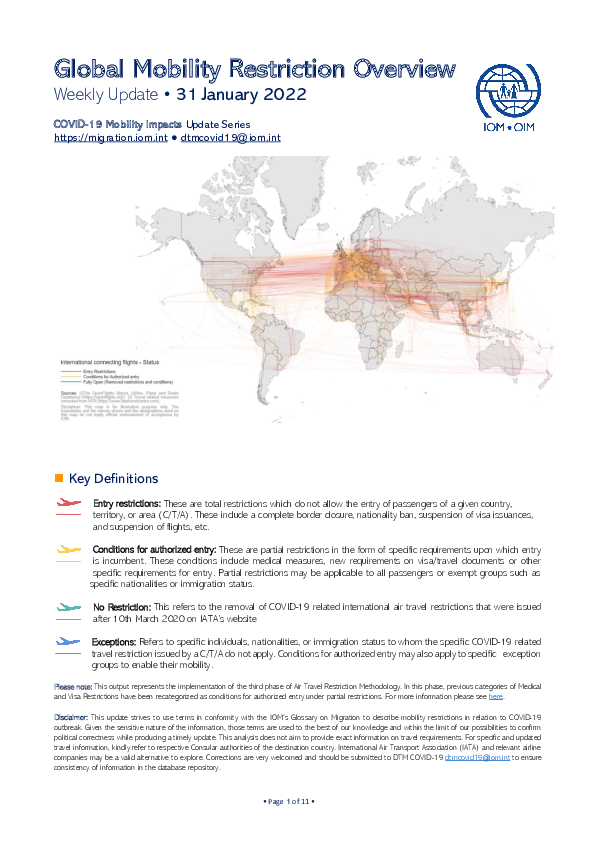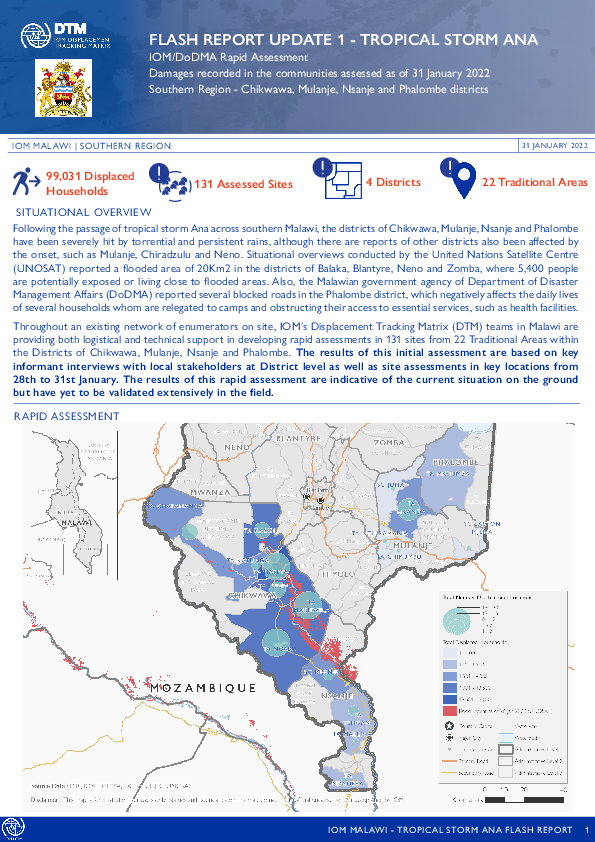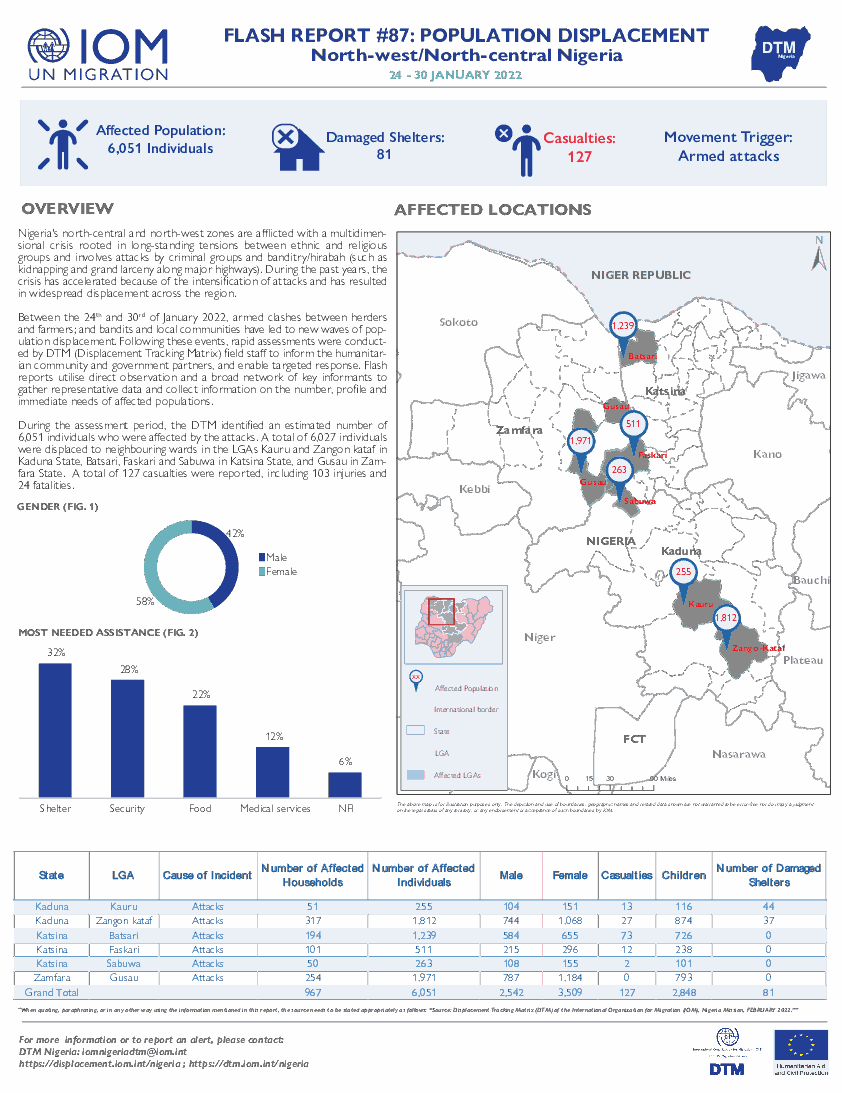-
Countries
-
Data and Analysis
-
Special Focus
-
Crisis Responses

Contact
DTM Mauritania, DTMMauritania@iom.int
Language
French
Location
Mauritania
Period Covered
Dec 01 2021
Dec 31 2021
Activity
- Event Tracking
- Flow Monitoring
La transhumance est une pratique de longue date en Mauritanie où elle a évolué au cours des dernières décennies telles que la raréfaction des ressources impliquant la redéfinition des routes empruntées par les troupeaux. Par conséquent, des conflits peuvent survenir lorsque les agriculteurs et les éleveurs transhumants. Dans le cadre du Suivi des Mouvements de Transhumance, l’OIM met en œuvre un système d’alerte qui a pour objectif de recenser les mouvements inattendus de bétail et les conflits ou catastrophes naturelles liés à l’utilisation des ressources naturelles et aux interactions entre agriculteurs et éleveurs, de comprendre les modes de résolution de conflits existants et d’informer les autorités compétentes, dans l’objectif de réduire les tensions dans les régions d’intervention. Ce tableau de bord présente les informations fournies par le biais de 21 informateurs clés, présents dans huit régions (Assaba, Brakna, Gorgol, Guidimakha, Hodh El Chargui, Hodh El Gharbi, Tagant et Trarza) pendant le mois de décembre 2021.
Contact
DTM Yemen, iomyemendtm@iom.int
Location
Yemen
Activity
- Event Tracking
- Mobility Tracking
Period Covered
Jan 30 2022 -Feb 05 2022
From 01 January 2022 to 5 February 2022, IOM Yemen DTM estimates that 2,638 households (HH) (15,828 Individuals) have experienced displacement at least once.
Since the beginning of 2022, DTM also identified 10 displaced households who left their locations of displacement and either moved back to their place of origin or another location.
Between 30 January and 05 February 2022, IOM Yemen DTM tracked 363 households (2,178 individuals) displaced at least once. The top three governorates and districts where people moved into/within are:
• Al Hodeidah (152 HH) – Hays (137 HH), Al Khukhah (15 HH) districts. Most displacements in the governorate originated from Al Hodeidah and Taiz.
• Marib (88 HH) – Marib City (62 HH), Harib (16 HH), Marib (10 HH) districts. Most displacements in the governorate originated from Marib and Dhamar.
• Taiz (45 HH) – Salah (16 HH), Jabal Habashi (14 HH), Al Mawasit (7 HH) districts. Most displacements in the governorate originated from Taiz and Al Hodeidah.
Most displacements resulted from the increased conflict in the following governorates and districts.
• Al Hodeidah (122 HH) – Hays (109 HH), Jabal Ras (10 HH), Zabid (3 HH) districts.
• Taiz (86 HH) – Maqbanah (54 HH), Jabal Habashi (15 HH), Dimnat Khadir (5 HH) districts.
• Marib (55 HH) – Harib (32 HH), Al Jubah (16 HH), Marib City (6 HH) districts.
Population Groups
Survey Methodology
Unit of Analysis Or Observation
Type of Survey or Assessment
Keywords
Geographical Scope
Administrative boundaries with available data
The current dataset covers the following administrative boundaries
Contact
DTM Malawi, DTMMalawi@iom.int
Location
Malawi
Activity
- Mobility Tracking
- Baseline Assessment
Period Covered
Jan 28 2022 -Jan 31 2022
A baseline assessment is a sub-component of mobility tracking. It aims to collect data on IDP, migrant or returnee population presence in a defined administrative area of the country.
This dataset contains displaced household figures at site level.
Population Groups
Survey Methodology
Unit of Analysis Or Observation
Type of Survey or Assessment
Keywords
Geographical Scope
Administrative boundaries with available data
The current dataset covers the following administrative boundaries

Contact
DTM Mozambique, DTMMozambique@iom.int
Language
English
Location
Mozambique
Period Covered
Jan 25 2022
Feb 02 2022
Activity
- Event Tracking
Following these events, rapid assessments were conducted by the International Organization for Migration (IOM) in collaboration with the National Institute for Disaster Management and Risk Reduction (INGD), from the 25 January 2022. Rapid assessments are still ongoing with a focus on understanding the extent of initial displacements as well as damages to houses and facilities across all affected localities in Tete, Niassa, Sofala, Nampula and Zambezia Provinces.
As a result of the impact of Tropical Depression Ana, an estimate of 50,768 families had their houses completely/partially damaged in the districts assessed so far. Of these 72% are in Nampula (36,681 houses), 18% in Zambezia (8,913 houses), 8% in Sofala (4,279 households) and 0.2% in Niassa (83 households). Assessment teams have completed data collection in 2 locations across Tete Sede-recording 812 houses (2%) completely/partially damaged. Further assessments in Teteare ongoing to evaluate extent of displacements across Mutarara, Dia and Zambue districts. In addition, 21 tents and 16 emergency shelters were completely or partially destroyed due to the rain and strong winds.
IOM/INGD identified 437 latrines and 8 water points damaged. Moreover, localities assessed so far identify at least 181 schools reporting partial and major damaged. Affected schools are in Nampula (69), Zambezia (87), Sofala (25) provinces. A total of 444 classrooms were completely or partially damaged in the affected schools.
In assessed locations

Contact
DTMcovid19@iom.int
Language
English
Location
Global
Snapshot Date
Jan 31 2022
Activity
- Other
The current outbreak of COVID-19 has affected global mobility in the form of various travel disruptions and restrictions. To better understand how COVID-19 affects global mobility, DTM has developed a COVID-19 database mapping the different restrictions to provide a global overview. For this, DTM uses the IATA site as the primary source of restrictions with the information reported per country and territory, and to the country of application.
Data collected includes:
- Date of restriction
- Country, territory or area of restriction
- Countries, territories or areas on which restrictions were imposed
- Type of restriction- total restriction, or conditional restriction – such as medical/ and or visa restriction
This DTM COVID-19 Travel Restrictions Output presents an analysis based on country imposing, the country being imposed upon, and the aggregation of the restriction type. The aim of the data analysis is to provide an overview of the COVID-19 outbreak on global mobility and to help identify and develop responses.
Feb 04 2022
Print
Countries in this response
- Active DTM operation
- Past DTM operation

Contact
DTM Malawi, DTMMalawi@iom.int ropretoriarmdhub@iom.int
Language
English
Location
Malawi
Period Covered
Jan 28 2022
Jan 31 2022
Activity
- Event Tracking
Following the passage of tropical storm Ana across southern Malawi, the districts of Chikwawa, Mulanje, Nsanje and Phalombe have been severely hit by torrential and persistent rains, although there are reports of other districts also been affected by the onset, such as Mulanje, Chiradzulu and Neno. Situational overviews conducted by the United Nations Satellite Centre (UNOSAT) reported a flooded area of 20Km2 in the districts of Balaka, Blantyre, Neno and Zomba, where 5,400 people are potentially exposed or living close to flooded areas. Also, the Malawian government agency of Department of Disaster Management Affairs (DoDMA) reported several blocked roads in the Phalombe district, which negatively affects the daily lives of several households whom are relegated to camps and obstructing their access to essential services, such as health facilities.
Throughout an existing network of enumerators on site, IOM’s Displacement Tracking Matrix (DTM) teams in Malawi are providing both logistical and technical support in developing rapid assessments in 131 sites from 22 Traditional Areas within the Districts of Chikwawa, Mulanje, Nsanje and Phalombe. The results of this initial assessment are based on key informant interviews with local stakeholders at District level as well as site assessments in key locations from 28th to 31st January. The results of this rapid assessment are indicative of the current situation on the ground but have yet to be validated extensively in the field.

Contact
DTM Nigeria, AllUsersInDTMNigeria@iom.int
Language
English
Location
Nigeria
Period Covered
Jan 24 2022
Jan 30 2022
Activity
- Event Tracking
- Mobility Tracking
Nigeria's north-central and north-west zones are afflicted with a multidimensional crisis rooted in long-standing tensions between ethnic and religious groups and involves attacks by criminal groups and banditry/hirabah (such as kidnapping and grand larceny along major highways). During the past years, the crisis has accelerated because of the intensification of attacks and has resulted
in widespread displacement across the region.
Between the 24th and 30th of January 2022, armed clashes between herders and farmers; and bandits and local communities have led to new waves of population displacement. Following these events, rapid assessments were conducted by DTM (Displacement Tracking Matrix) field staff to inform the humanitarian community and government partners, and enable targeted response. Flash reports utilise direct observation and a broad network of key informants to gather representative data and collect information on the number, profile and immediate needs of affected populations.

Contact
DTM Nigeria, AllUsersInDTMNigeria@iom.int
Language
English
Location
Nigeria
Period Covered
Jan 01 2022
Jan 31 2022
Activity
- Mobility Tracking
- Baseline Assessment
- Points of Entry (PoE)
During the COVID-19 pandemic, IOM's Displacement Tracking Matrix (DTM), in collaboration with the World Health Organization (WHO), monitors the movements to and from Nigeria's Adamawa and Borno States in the North East Nigeria. Assessments are conducted at Points of Entry located along the border with Cameroon.
During the period 01 - 31 January 2022, 1,063 movements were observed at three Points of Entry in Borno state. Of the total movements recorded, 541 were incoming from the Far North Region in Cameroon while 15 were incoming from Bol, three from Adre and six from Ndjamena in Chad republic. Additionally, 492 outgoing movements were recorded from Borno State to the
Far North Region in Cameroon and six outgoing movement to Lai and Bol in Chad republic.

Contact
DTM Nigeria, AllUsersInDTMNigeria@iom.int
Language
English
Location
Nigeria
Period Covered
Jan 22 2022
Jan 28 2022
Activity
- Mobility Tracking
- Baseline Assessment
- Points of Entry (PoE)
During the COVID-19 pandemic, IOM's Displacement Tracking Matrix (DTM), in collaboration with the World Health Organization (WHO), monitors the movements to and from Nigeria's Adamawa and Borno States in north-east Nigeria. Assessments are conducted at Points of Entry located along the border with Cameroon.
During the period 22 - 28 January 2022, 242 movements were observed at three Points of Entry in Borno state. Of the total movements recorded, 107 were incoming from the Far North Region in Cameroon, while 135 outgoing movements were recorded from Borno State to the Far North Region in Cameroon.